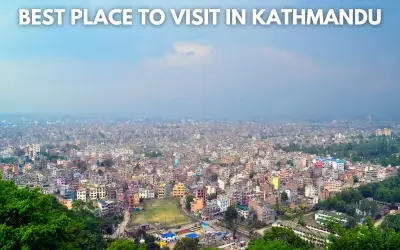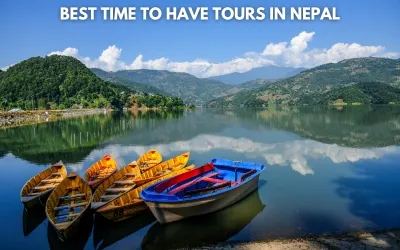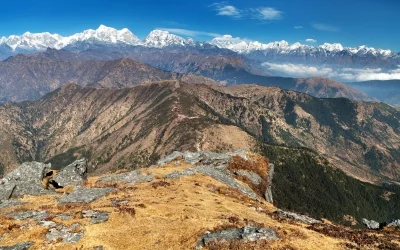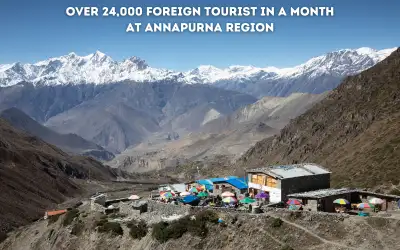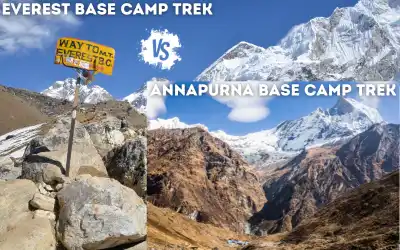Pikey Peak Trek Cost
December 9, 2023Pikey Peak Trek is one of the short treks in the Everest Region that offers one of the best views of Mt. Everest. Mt. Everest, also called Sagarmatha, is the tallest mountain peak in the world with an elevation of 8848.86m.
Many trekkers and foreign tourists visit Nepal just to catch glimpses of Mt. Everest. But not everyone wants to have the strenuous, long-day treks that last more than 15 days. So, what could be a better option than the Pikey Peak trek? Many say that the view of Mt. Everest from Pikey Peak is one of the best in Nepal.
But the question is: What does the Pikey Peak Trek cost? Answering the question, we are writing this blog to give you a detailed breakdown of the cost and some of the best tips on how to minimize extra expenses.
Without further ado, let’s start with a short overview of the Pikey Peak trek and further go into details about the cost of trekking to Pikey Peak. Excited? Hold on to your excitement because we, Blue Lake Travels and Tours, offer you several trekking and tour packages in Nepal that are surely going to hype your excitement.
Pikey Peak Trek Overview
The Pikey Peak Trek is a moderately challenging trek in the Solukhumbu region of Nepal. With this trek, you can get stunning views of the Himalayas, including the iconic Mount Everest. In addition, it is one of the great ways to experience the Sherpa culture of the Everest region.
This is a 5-7-day trek starting from the major tourist hub of Nepal, Kathmandu City. The trek begins at Dhap, which is a small village in the lower Solukhumbu and serves as the starting point of the Pikey Peak trek. From Dhap, you will trek through the villages of Japre to reach the Pikey Base Camp, which is located at an elevation of 3,460m.
Then, the next day, the trek is a summit push to the top of Pikey Peak, which is 4,065 meters high. Pikey Peak is widely known for its beautiful sunrise view and several stunning views of the mountain ranges, including Mount Everest.
You will then trek to Phaplu, passing through the several villages of Loding, Jubesi, and Taksindu. From Phaplu, it is easily accessible to take a drive to Kathmandu, which usually takes 9–10 hours.
Pikey Peak Trek Itinerary
Here’s an overview of the Pikey Peak Itinerary, which is a 7-day trek starting from Kathmandu city.
- Day 01: Arrival in Kathmandu, drive to Dhap and trek to Japre
(Time: Kathmandu to Dhap drive: 8/9 hours; Trek to Japre from Dhap: 4 hours) - Day 02: Trek to Pikey Base Camp from Japre (8–9 hours)
- Day 03: Early morning summit to Pikey Peak and trek to Loding (8–9 hours)
- Day 04: Trek to Junbesi from Loding (4-5 hours)
- Day 05: Trek to Taksindu from Junbesi (5–6 hours)
- Day 06: Trek to Phaplu from Taksindu (5–6 hours)
- Day 07: Drive to Kathmadu from Phaplu (9–10 hours)
This is just a general itinerary, so you can customize it according to your wishes. For any further support or to get the Pikey Peak Package, you can contact Blue Lake Travels and Tours.
Pikey Peak Trek Cost: Detailed Breakdown
Pikey Peak Trek costs range from USD 650 to USD 850, considering the days of the trek, the accommodation options to go for and how luxurious you want the trek to be. This is a general figure of the cost so you can either make it higher by choosing the more luxurious trek or lower by reducing the expenses.
This cost includes local transportation by bus or jeep, permit fees, food, and accommodation. Also, the cost of the Pikey Peak can be affected by the season you choose to travel in.
With this, you can expect to pay around USD 650 to USD 850 per person for a 7–10-day Pikey Peak Trek. Here is a detailed breakdown of the cost of trekking to Pikey Peak:
Permits and Fees
Permits are necessary for every trek in Nepal, as they help you get entry to the restricted area. The permits involved in the Pikey Peak Trek are the TIMS Card, the Sagarmatha National Park Permit and the Pikey Peak Climbing Permit.
The TIMS (Trekkers’ Information Management System) card costs USD 20 per person and is available at the Nepal Tourism Board (NTB) in Kathmandu and Pokhara. For a Sagarmatha National Park permit, you have to pay USD 30 per person. You can get the permit at the entrance of the Sagarmatha National Park or from the Tourism Board itself.
During this trek, you are required to pay NPR 3,000 (about USD 30) per person for the Gauri Shankar Conservation Area Permit. Lastly, about USD 17, which is about NPR 2000 per person for the local area permit, while having the Pikey Peak Trek.
Also, do you know? With the Pikey Peak Trek package by Blue Lake Travels and Tours, you don’t have to pay the permit fees or struggle to get the permits, as they are all managed by the team.
Accommodation and Food Costs
Accommodation and food are important throughout the trek, as you need to have a shelter at night and food to keep up the strength for trekking. While the cost of food and accommodation is dependent on how you spend, here are some general costs during the Pikey Peak trek.
The accommodations available during the trek are the tea houses, which usually charge between USD 5 and USD 10 per person per night. You can also go for camping but it is not recommended as it doesn’t provide enough warmth at night. But if you are well equipped with the necessary items to prevent the cold, you can go camping too.
For food and water, you can have the regular breakfast, lunch and dinner. For the general breakfast available during the Pikey Peak Trek, it can cost you roughly around USD 5-7 per person. For lunch and dinner, you can have the Dal Bhat, with additional items for about USD 9 to 12 per person.
Also, you can get light snacks during the trek for about USD 3 to USD 5. The water can cost a bit more while trekking at a higher altitude and it can cost you around USD 3–4 per person per day. Also, remember that it is important to remain hydrated while trekking at higher altitudes to prevent altitude sickness.
Guide and Porter Cost
Though considering it a moderate trek in Nepal, you might be thinking of having a solo trek, but it is not allowed as the Nepal Tourism Board has prohibited solo treks in Nepal.
It is now important to hire a government-licensed guide while trekking in Nepal. So, for Pikey Peak Trek, you need to hire an experienced government-licensed guide. Hiring a guide for the Pikey Peak Trek can cost you around USD 25 to USD 35 per day, excluding the tips.
You can minimize the cost by not hiring a porter and carrying only important things in your backpack. However, it might cost you USD 20 per day to hire a porter while trekking to Pikey Peak.
It is always a better option to go with guide and porter, as they are familiar with the routes and weather and can help you with every necessary things like communicating with the locals, managing accommodations, foods, etc.
Good thing for you because Blue Lake Travels and Tours also offers guide porter hire in Nepal service at the best price available for trekking in every region of Nepal.
Transportation Cost
When it comes to transportation costs, it can cost more if you choose to have private transportation but it can always be minimized by taking shared or public transportation.
After arriving in Nepal, you can either take a taxi, bus or motorcycle to reach your hotel. While booking the package with us, you can get free airport pickup and drop-off, but without a package, you have to pay roughly around NRs 500 to NRs 700 for a taxi.
While the bus fare is less expensive, costing you only NRs 20 to NRs 30. You can also choose to have a motorcycle ride to your hotel and it can cost you somewhere around NRs 200.
The trek to Pikey Peak starts from the Dhap Bazaar, which is easily accessible from Kathmandu by taking different means of transportation, including private jeeps, shared jeep and public transportation.
The cost for the private jeep, shared jeep and public transportation to reach Dhap Bazaar from Kathmandu City is USD 300, USD 20 and USD 10 per person, respectively.
Taking about the time, it can take around 7 hours in a private jeep, 10 hours in a shared jeep ride and almost 12 hours in public transportation.
While returning from Phaplu to Kathmandu, the cost of transportation is basically the same, but you can catch an airplane flight too, which can cost you around USD 200 per person.
Remember that the transportation cost is included with the package by Blue Lake Travels and Tours so if you find it hard to find transportation and manage the cost, let us do it for you.
With this, you can get a surface idea of how much transportation can cost you during the Pikey Peak Trek. You can estimate somewhere around USD 200 to USD 800 for transportation on the Pikey Peak Trek.
Supplies and gear cost
It is important to be fully equipped with the necessary gear and supplies during the Pikey Peak Trek. However, you don’t need specialized trekking gear and equipment for this trek, but here are some of the basic requirements recommended:
- Waterproof trousers
- Trekking boots
- Day pack
- Down jacket
- Fleece inner
- Woolen hat
- Waterproof jacket
- Trekking socks
- Gloves
- Scarf
- Sunglasses
- Sleeping bag
- Trekking poles
- Headlamp
- Water bottle
- First-aid kit
- Toiletries (toothbrush, toothpaste, shampoo, soap, deodorant, sunscreen with high SPF, wet wipes, insect repellent, etc.)
- Documents (passport, visa, travel insurance, trekking permits, TIMS card)
If you are planning to go on treks in the winter season, then you need to have better gear to protect you from the colder nights at the higher altitude.
The approximate cost of the gear and equipment is around USD 200 to USD 300. But you can minimize the cost by renting trekking gear and equipment in Kathmandu, which will cost you on the basis of the equipment per day.
How do I minimize the cost of trekking to Pikey Peak?
The cost of trekking to Pikey Peak completely depends on how you manage it, how you wish to spend it, how many days you want to spend on the trek, the facilities of food and accommodation you want to go for and nevertheless, the gear you want to purchase.
The best way to minimize the trek and avoid spending more is by joining a group that is planning to trek to Pikey Peak. By the way, you may not be aware that Blue Lake Travels and Tours offers group tours.
Instead of getting the package, you can also get the group membership from us. For that, contact us through WhatsApp at +9779851076943 today.
In order to minimize the overall cost of the trek, you can do these things:
- Trek during the off-season (November–March)
- Choose a camp instead of staying in teahouses
- Bring your own food and water
- Get the package with Blue Lake Travels and Tours that includes airport pickup and drop, permit fees, foods, accommodation, transportation, and guides.
You can get the Pikey Peak Trek package of nine days with us for just USD.
Conclusion
If you are looking for a week-long trek in Nepal, the Pikey Peak Trek can be one of the best options because it offers you one of the best views of Mt. Everest. The cost of the trek is totally dependent of how much you wish to spend on logistics, services, foods, accommodations, etc.
In order to save money while trekking, you can avoid luxury options for food and accommodation that will save you a lot. Also, it is better to join a group for transportation or more than that, getting a package with us can help you save a lot.
Planning to go on a trek to Pikey Peak? Drop a comment below, send us a quick inquiry through the contact page or for faster replies, you can send a message on WhatsApp at +9779851076943 or send us an email at info@travelagencyinnepal.com!
Frequently Asked Questions
What is the average cost of the Pikey Peak Trek?
The average cost of the Pikey Peak Trek ranges from USD 650 to USD 850. This includes shared local transportation (bus or jeep) but might not include everything else, like:
- Accommodation: Tea houses along the trek route.
- Food: Breakfast, lunch, and dinner during the trek.
- Guide and porter: Optional but recommended, especially for first-time trekkers.
- Permits: National park entry permit and TIMS card.
- Personal gear: Trekking boots, backpack, sleeping bag, etc.
What factors affect the cost of the Pikey Peak Trek?
Several factors can affect the cost of your trek, including:
- Group size: Smaller groups will generally pay more per person than larger groups.
- Season: Trekking during peak season (March–May and September–November) will be more expensive than during shoulder seasons (June–August and December–February).
- Travel style: If you prefer comfortable lodges with private rooms and hot showers, expect to pay more than those who are okay with basic tea houses and shared facilities.
- Guide and porter: Hiring a guide and porter will add to the cost, but it can be a wise investment for safety and convenience.
- Additional activities: If you want to add on other activities like side trips or peak climbing, expect to pay additional fees.
How can I save money on the Pikey Peak Trek?
Here are some tips for saving money on your trek:
- Travel during the shoulder seasons: You can save money on flights and accommodation by avoiding peak season.
- Choose a smaller group size: Sharing costs with more people will make the trek less expensive.
- Stay in tea houses: Tea houses are generally cheaper than lodges.
- Bring your own gear: If you can, rent or borrow gear instead of buying it new.
- Cook your own food: This is a great way to save money on meals.
- Hire a porter instead of a guide: Porters are typically cheaper than guides and can help carry your gear.
- Book your trek directly with a local operator: This can save you money compared to booking with an international tour company.
What is included in a typical Pikey Peak Trek package?
A typical Pikey Peak Trek package will include:
- Accommodation: Tea houses along the trek route.
- Food: Breakfast, lunch, and dinner during the trek.
- Local transportation: Shared bus or jeep.
- National park entry permit and TIMS card.
- Guide and porter (optional).
Do I need a guide and porter for the Pikey Peak Trek?
A guide and porter are not required for the Pikey Peak Trek, but they are recommended, especially for first-time trekkers. A guide can help you navigate the trails, provide cultural insights, and ensure your safety. A porter can help carry your gear, which can make the trek more enjoyable.



